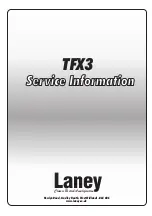
10.5 Network settings menu
The Network settings menu become available when the
AESOP board is installed (ref. FIGURE 20).
Many of the menus in this section require the user to select
one functioning mode from a set of possible alternatives.
These alternatives are all presented in a list. A black diamond
shape next to a specific item in the list indicates that is the
selected option.
•
Device mode: this parameter sets the amplifier mode
with respect to the AES3 stream (ref. Chapter 10 : 2.
AESOP repeater mode and Chapter 10 : 3.EASOP
forward mode). Available options are:
•
Repeater (default); Forward to AES3-A;
•
Forward to AES3-B;
•
Forward to both.
Note: when an amplifier is in forward mode (either to AES3-A,
AES3-B or both) the amplifier can only accept the AES
signal coming from the AES3-XLR connector. AES3 streams
incoming from any other RJ45 port are ignored.
•
Addressing Mode: this parameter controls the IP
addressing assignment strategy:
•
Manual: requires the user to set a valid static
address and subnet mask (and, optionally, the
default gateway). The PC should be on the same
subnet of the amplifier if no routers are present
between the PC and amplifier.
•
Automatic: lets the amplifier ask and obtain
a network configuration from a DHCP server.
Starting from power-on, the amplifier tries to
obtain a valid IP address from a DHCP server. After
a timeout of 30 seconds, if an IP address is not
obtained, the amplifier takes an automatic private
address in the range 169.254.x.y, but continues
to search for a DHCP server. When the DHCP
becomes available, the address is updated. If no
DHCP server is available, the amplifier obtains an
IP address by Automatic IP (local link addressing
or ZeroConf).
The amplifier behaviour complies with RFC 3927,
guaranteeing the interoperability with any host PC supporting
this standard.
•
Set address: this menu allows to manually set the
amplifier’s IP address, subnet mask and default
gateway.
•
Show net config: this menu shows the current
networking configuration, either set by the user via the
“Set address” menu or obtained automatically if the
automatic addressing mode is selected.
•
Audio
•
Source selection: this menu allows the user to
select the AES3 stream source to feed the output
power stage. The AES3 signal can come from
either: AES3-XLR, AES3-A or AES3-B.
•
Source mode: this menu allows to selects the
channel(s) contained the selected AES stream to
be forwarded to the output power stage of the
amplifier. The possibilities are: Parallel from L (the
left channel from the selected AES3 stream is
forwarded to both amplifier channels), Parallel from
R (the right channel from the selected AES3 stream
is forwarded to both amplifier channels), Stereo
(the right channel from the selected AES3 stream
goes to channel 1 or the amplifier; the right channel
from the AES3 stream goes to the amplifier’s left
channel).
•
Gain trim: this parameter trims the digital level of
the AES3 stream. The gain trim scale goes from
+5 dB to -40 dB with 0.5 dB steps with respect
to 0 dB equivalent of +13.5 dBu. A 0 dBFS level
in the AES3 stream corresponds to an absolute
analog level of +18.5 dBu when a +5 dB gain trim
level is applied.
•
If no link: this parameter allows the user to choose
the behaviour of the amplifier when the digital audio
stream is missing and the “Input selection” is set
as AESOP
OUT (or AESOP
DSP
OUT). The
two possible alternatives are: Mute and Analog. In
Analog mode the amplifier automatically switches
to CH1/CH2 analog input if the digital stream is
missing, returning to the digital stream in case
this should become available again. This mode
could be used to implement an analog backup
connection for the digital stream (ref. Chapter
10 : 4.4. Two degree redundant daisy chain).
10.4.4 Two degree redundant daisy chain
If the amplifiers in the daisy chain are fed with mono signal
and the channel of each unit are linked – so that to use the
same input signal (ref. Chapter 9 : 10.1. Source selection)
–, a two degree redundant connection topology can be
achieved.
Taking advantage of the “if no link” features in the Network
settings menu (ref. Chapter 10 : 5.Network settings menu),
the K Series can switch to the analog input when the AESOP
stream fails. Bearing this in mind, it is possible to achieve
high degree of redundancy exploiting both digital and analog
inputs.
Remember that when operating with digital inputs – i.e. AES3
and AESOP – channel link must be achieved via software: do
not switch the link pushbutton.
The network topology is described in FIGURE 46.
Bias Series User Guide V1.0
Page 31












































